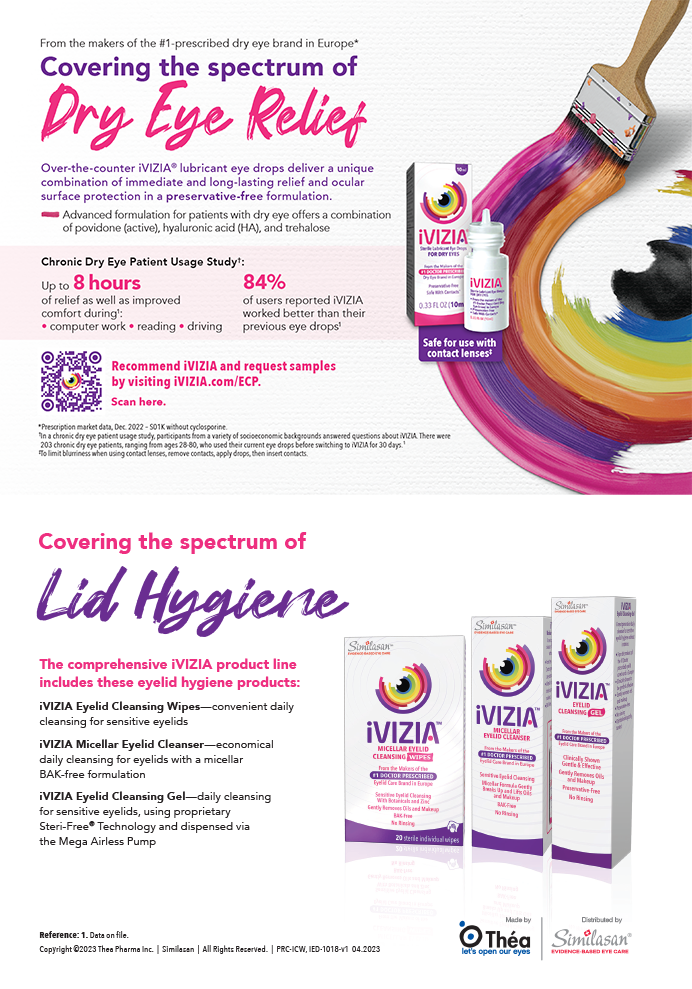The challenges of properly aligning toric IOLs are familiar. Even with careful marking of the intended axis of correction on the peripheral cornea, the IOL will often align correctly with the mark on one side but not on the other. Perhaps the IOL will sit with the toric marks parallel to—but not exactly aligned with— the axial marks. Then, there is the issue of parallax: the lens appears to be aligned from one angle of view but not from another, making it hard to know whether the lens is actually positioned correctly. Many factors can make toric IOL alignment challenging, including the limitations of ink markings, changes in head position, pupillary dilation, fixation from preoperatively to intraoperatively, and the significant parallax that occurs when marks on the cornea are viewed relative to the IOL plane.
THE CORRECT AXIS OF ASTIGMATISM
Much of the discussion around the accurate positioning of toric IOLs concerns the identification of and placement on the correct axis of astigmatism. Correct axial alignment of a toric IOL is critical, but it must be preceded by proper centration of the IOL. Just like an analog clock, if the hands are not mounted properly at the center of the clock face, they will not accurately point to the minute or hour marks. Similarly, when iris registration (IR) was introduced in corneal laser refractive surgery, the initial focus was on preventing treatment misalignment due to cyclorotation. It quickly became apparent, however, that, for most eyes, the compensation for pupillary centroid shift was the more significant contributor to accurate ablation than the rotational component.1
When it comes to centration, we can learn from our experience with diffractive multifocal IOLs. These lenses’ distinctive rings make centration (or lack thereof) more noticeable and have brought greater attention to the importance and manner of centering IOLs. Although toric lenses do not have rings to help us visualize the IOL’s center, we can still use the same principles to improve toric lens centration.
PEARLS FOR CENTERING TORIC IOLs
There are several possible intraoperative reference points for centration. Although it may be tempting to center a diffractive multifocal IOL on the pupil and a toric IOL on the limbus, these may not be the best references for centration. In my opinion, the surgeon should center on the coaxially sighted corneal light reflex (CSCLR), which correlates closely with the visual axis.
When marking the cardinal axes on the eye prior to toric IOL implantation, the marks should be along the 0º and/or 90º meridians, centered on the CSCLR. To achieve this orientation, the patient should ideally be fixating on a coaxial light as the surgeon marks the cardinal axes. I mark the 0º and 180º axes by referencing the pupil’s image from my topographer, which images a true CSCLR. I use iris features and limbal contours from the topographic image to guide my preoperative marking of the cardinal axes at the slit lamp. I make all marks with a fine-tipped ink pen and indent the epithelium so that I can find the center of the mark even if the ink bleeds.
Intraoperatively, I have the patient fixate on a coaxial light source at the beginning of the case. On my Lumera (Carl Zeiss Meditec) operating microscope, this correlates with one of the two stereo coaxial lights. I then place the toric axis marker and make my axial marks, while taking care that they are centered on the aligned CSCLR. As mentioned earlier, the center of a toric IOL can be more challenging to localize than the center of a multifocal IOL, but it is still relatively easy to align the CSCLR between the two sets of alignment dots on a toric IOL. As I am rotating the IOL to match up its alignment dots with my corneal axial marks, I again ask the patient to fixate on the coaxial light source. When everything is aligned correctly and the patient is fixating at the coaxial light source, I should be able to draw a straight line through all five reference points—the two corneal axial marks, the two sets of axis-marking dots on the IOL, and the CSCLR (Figure 1). If the CSCLR is not aligned with the corneal axial marks, I prefer to align the IOL with the CSCLR and parallel to the corneal axial marks (Figure 2). Good centration and patient fixation eliminate the concern for parallax so proper alignment can be confirmed.
DOES ALIGNMENT MATTER?
We know that each degree of rotational misalignment reduces the toric effect by 3.3%.2 If the lens is decentered and misaligned, the reduction in effect could be even greater.
Fortunately, patients who opt for toric lenses are typically a little less demanding than other premium IOL patients in terms of expectations. My preferred toric implant, the Tecnis Toric (Abbott Medical Optics), tends to be somewhat forgiving of minor misalignment thanks to its superior chromatic and spherical aberration characteristics. As we surgeons increasingly focus on obtaining the best possible outcomes in premium IOL surgery, centration and alignment are both issues to which we should be paying closer attention.
CONCLUSION
Centering an IOL is an important component in optimizing the lens’ position and achieving the best possible visual results with any IOL. When implanting a toric lens, centration becomes the critical first step in achieving rotational alignment. Without good centration, we are only approximating the toric axis—hardly an ideal situation for any surgeon striving for precision in modern cataract surgery.
Daniel H. Chang, MD, is a partner at Empire Eye and Laser Center in Bakersfield, California. He is a consultant to Abbott Medical Optics. Dr. Chang may be reached at (661) 325-3937; dchang@empireeyeandlaser.com.
- Koch DD, Wang L. Clinical benefit of compensation for cyclorotation and pupil centroid shift. Paper presented at: XXIV Congress of the European Society of Cataract & Refractive Surgeons; September 9-13, 2006; London, UK.
- Novis C. Astigmatism and toric intraocular lenses. Curr Opin Ophthalmol. 2000;11:47-50.


